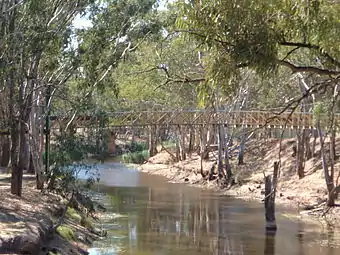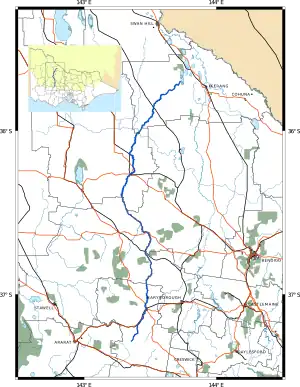Avoca River
The Avoca River, an inland intermittent river of the north–central catchment, part of the Murray-Darling basin, is located in the lower Riverina bioregion and Central Highlands and Wimmera regions of the Australian state of Victoria. The headwaters of the Avoca River rise on the northern slopes of the Pyrenees Range and descend to flow into the ephemeral Kerang Lakes.
| Avoca | |
|---|---|
 Avoca River at Charlton | |
 Course of the Avoca River | |
| Native name | Natte yaluk, Boca, Bangyeno Banip,Djub-djub-galg, Witchelliba, Yangeba[1][2] |
| Location | |
| Country | Australia |
| State | Victoria |
| Region | Riverina bioregion (IBRA), Central Highlands, Wimmera |
| Local government areas | Buloke, Gannawarra |
| Towns | Avoca, Logan, Charlton, Quambatook |
| Physical characteristics | |
| Source | Pyrenees Ranges, Great Dividing Range |
| • location | below Mount Lonarch |
| • coordinates | 37°14′03″S 143°24′21″E |
| • elevation | 307 m (1,007 ft) |
| Mouth | Lake Bael Bael, Kerang Lakes |
• location | Kerang |
• coordinates | 35°41′57″S 143°44′32″E |
• elevation | 74 m (243 ft) |
| Length | 270 km (170 mi) |
| Basin size | 12,352 km2 (4,769 sq mi) |
| Discharge | |
| • average | 5 m3/s (180 cu ft/s) |
| Basin features | |
| River system | North–central catchment, Murray-Darling basin |
| Tributaries | |
| • left | Glenlogie Creek, Number Two Creek, Mountain Creek (Victoria), Cherry Tree Creek, Smoky Creek, Tarpaulin Creek, Campbell Creek (Victoria) |
| • right | Sandy Creek (Victoria), Brown Hill Creek (Victoria), Fentons Creek (Victoria), Sandy Creek (Victoria), Yeungroon Creek, Mosquito Creek (Victoria) |
| [3][4] | |
Features and location
The Avoca River drains a substantial part of central Victoria. It rises at the foot of Mount Lonarch, near the small town of Amphitheatre, and flows north for 270 kilometres (170 mi)[5] joined by thirteen minor tributaries, and through the towns of Avoca, Charlton and Quambatook. Two major distributaries leave the Avoca River between Charlton and Quambatook: Tyrrell Creek, flowing to Lake Tyrrell, and Lalbert Creek flowing to Lake Lalbert.
Although the Avoca River basin is part of the Murray-Darling basin,[6] the Avoca River does not empty into the Murray. Nowhere a large stream, it dwindles as it flows north, eventually terminating in the Kerang Lakes,[6] a network of ephemeral swamps west of Kerang and about 20 kilometres (12 mi) south of the Murray River.[3]
Although the Avoca River has a substantial 12,000-square-kilometre (4,600 sq mi) catchment area,[5] the fifth-largest in Victoria, most of that area is on the northern plains where rainfall averages only about 350 millimetres (14 in) per year,[5] and where there is little runoff because the terrain is very flat. The mean annual runoff of 137 gigalitres (30×109 imp gal; 36×109 US gal) per annum accounts for only 0.67% of Victoria's runoff.[7] Most of the water flowing in the Avoca River originates in the small upper portion of the catchment area, where rainfall averages about 600 millimetres (24 in) per year,[5] most of it falling in the winter and spring.[8]
Of all the Victorian rivers in the Murray-Darling basin, the Avoca River is the most variable.[5] The average annual flow is 85 gigalitres (19×109 imp gal; 22×109 US gal), but recorded actual flows have varied from almost five times the average figure in very wet years, when the river can flood, to 0.5% of the average in drought years, when the flow is less than 50 megalitres (11×106 imp gal; 13×106 US gal) per day. In dry years, the flow can stop for many months.[4]
Although it is the only river of significance in the area, no major water storages have been constructed on it, but there are six weirs of only local significance. Little use of the river is made for irrigation because, during the peak demand periods of summer and autumn, it is often not flowing. During low-flow periods, the water is usually too saline to use on crops, but can still provide drinking water for sheep and cattle.[4]
The river is crossed by the Pyrenees Highway at Avoca, and the Borung Highway and the Calder Highway at Charlton.[3]
Etymology
As the river is relatively long, Aboriginal peoples from various cultural groups lived near the river course. In the Djadjawurrung, Wathawurrung, Wergaia, and Wembawemba languages, the river has several names, including Natte yaluk and Boca, both with no clearly defined meaning; Bangyeno Banip, meaning bunyip waterholes; Djub-djub-galg, meaning a place where melaleuca was abundant; Witchelliba, with witji meaning basket grass and bar meaning river; and Yangeba, with no clearly defined meaning.[1][2]
References
- "Avoca River (entry 613200)". VICNAMES. Government of Victoria. Retrieved 18 October 2014.
- Clark, Ian; Heydon, Toby (2011). "Avoca River: Traditional Names". Victorian Aboriginal Corporation for Languages.
- "Map of Avoca River, VIC". Bonzle Digital Atlas of Australia. Retrieved 18 October 2014.
- "Avoca - Angling Waters". Fishing guides. Department of Sustainability and Environment, Government of Victoria. 22 August 2014. Archived from the original on 22 October 2014. Retrieved 18 October 2014.
- "Rivers - Assessment of River Condition - Victoria". Archived from the original on 13 October 2010. Retrieved 5 February 2011.
- "State Water Report 2004/05" (PDF) (PDF). Victorian Government. Archived from the original (PDF) on 28 June 2009. Retrieved 5 February 2011.
- "Water resources - Availability - Victoria". Archived from the original on 18 February 2011. Retrieved 5 February 2011.
- CSIRO (May 2008). Water availability in the Loddon-Avoca: A report to the Australian Government (PDF). ISSN 1835-095X. Retrieved 5 February 2011.
{{cite book}}:|work=ignored (help)
External links
- "Wimmera-Avoca". Murray-Darling Basin Authority. Australian Government. 2014. Archived from the original on 23 October 2014. Retrieved 18 October 2014.
- "Avoca River longitudinal profile" (PDF). Murray-Darling Basin Authority (PDF). Australian Government. Archived from the original (PDF) on 15 February 2014.
- "Avoca". Our rivers. Environment Victoria. 14 September 2016.